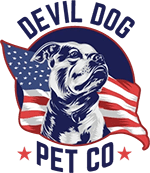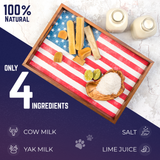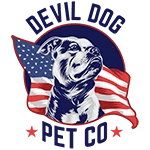Key Takeaways
- Dog diaper covers provide a practical solution for managing incontinence and heat cycles in dogs.
- They help maintain your dog's dignity while addressing underlying issues.
- Reusable diaper covers are more environmentally friendly and cost-effective than disposable options.
- Quality covers are designed to fit your dog's anatomy comfortably and securely.
Table of Contents
- What Are Dog Diaper Covers?
- Choosing the Right Dog Diaper Cover for Your Dog
- How to Measure, Fit, and Use Dog Diaper Covers
- Cleaning, Maintenance, and Long-Term Care of Reusable Diaper Covers
- Real-World Applications: Who Needs Dog Diaper Covers and Why?
- Comparison Guide: Types, Materials, and Closure Systems
- Best Dog Diaper Covers for Every Need: Our Top Picks
The Ultimate Guide to Dog Diaper Covers: Solving Real Problems with Extreme Dog Leadership
When your senior dog starts leaving surprise puddles or your female pup's heat cycle threatens your favorite rug, you need more than crossed fingers and paper towels. Dog diaper covers offer a tactical solution that keeps dignity intact while you address the root cause. Unlike disposable diapers that create waste and ongoing costs, quality covers provide reusable protection that works with your dog's anatomy, not against it.
The difference between managing incontinence and mastering it comes down to the right gear and leadership mindset. Skip the guesswork, here's your complete intel on choosing, fitting, and using dog diaper covers that actually work.
For larger breeds, finding the right fit is crucial. Explore options for dogs between 45-70 lbs or extra-large dogs to ensure maximum comfort and leak protection.
What Are Dog Diaper Covers?
Definition & Anatomy
A dog diaper cover is the outer shell that holds absorbent pads in place against your dog's body. Unlike all-in-one disposable diapers, covers separate the waterproof barrier from the absorption layer, letting you swap out liners while reusing the fitted harness. Quality covers feature adjustable straps, tail holes sized for comfort, and closure systems designed to stay secure during normal activity.
The anatomy matters: elastic leg openings prevent leaks without cutting circulation, while reinforced seams handle the stress of an active dog. Cheaper covers skip these details and fail when you need them most.
Why & When Are They Needed?
Medical incontinence tops the list, senior dogs lose bladder control due to weakened sphincter muscles, while post-surgical pups need protection during recovery. Female dogs in heat require covers to manage spotting and keep your home clean. Anxiety-driven marking and house-training support round out the primary use cases.
Quick Answer: Is a dog diaper cover right for your situation?
- Incontinence (age/medical): Full coverage diaper cover
- Male marking only: Belly band
- Female in heat: Full coverage with extra absorbent pads
- Post-surgery protection: Lightweight, breathable cover
Types of Dog Diaper Covers
Full coverage covers wrap around the hindquarters with openings for legs and tail, essential for female dogs and any fecal incontinence. Belly bands target male urinary issues by covering only the penis area. Partial coverage options exist but offer limited protection.
Gender anatomy drives the choice: males need coverage from chest to mid-belly, while females require full rear coverage. Size ranges from toy breed options under 5 pounds to giant breed covers for 150+ pound dogs.
Choosing the Right Dog Diaper Cover for Your Dog

Size, Fit, and Comfort: No "One-Size-Fits-All"
Measure your dog's waist at the narrowest point behind the ribcage, then measure from the base of the tail to the front of the hind legs. Add the girth measurement around the widest part of the chest. These three numbers determine proper fit, too loose allows leaks, too tight restricts movement and causes chafing.
Breed-specific considerations matter: long-backed dogs need extended coverage, while short-legged breeds require adjusted leg openings. Dexter's measurements guide our sizing recommendations, but every dog's proportions vary. When between sizes, go larger and adjust straps rather than risk a restrictive fit.
Material Selection: Durability vs. Skin Safety
Outer shells should combine waterproof protection with breathability, look for PUL (polyurethane laminate) fabric that blocks moisture while allowing air circulation. Inner linings need soft, non-irritating materials like cotton or bamboo blends that wick moisture away from skin.
Avoid cheap vinyl or plastic covers that trap heat and cause skin breakdown. Quality materials cost more upfront but prevent expensive vet visits for contact dermatitis. Reusable covers made with medical-grade fabrics outlast dozens of disposable alternatives.
Closure Systems: Snaps, Velcro, Hook and Eye, Which Works Best?
Velcro offers infinite adjustability but loses grip after repeated washing and can catch on furniture or fur. Snaps provide secure closure and durability through hundreds of wash cycles, though they offer less size flexibility. Hook-and-eye systems combine adjustability with longevity but require more dexterity to fasten.
For escape artists and high-energy dogs, dual closure systems work best, primary snaps with backup velcro strips. Senior dogs benefit from easy-release velcro for quick changes, while overnight use demands the security of snaps or hooks.
How to Measure, Fit, and Use Dog Diaper Covers
Step-by-Step Sizing and Fitting Process
Start with your dog in a calm, standing position. Measure the waist where a belt would sit, typically 2-3 inches behind the front legs at the narrowest torso point. Record this measurement in inches. Next, measure from the base of the tail to where you want front coverage, usually just behind the front legs for females or mid-chest for males.
The tail hole requires special attention. Measure the circumference around the tail base, not the thick part where it attaches to the body, but about 2 inches down where the cover's tail hole will sit. Add 1-2 inches for comfort and movement.
Pro Measuring Tip
Take measurements when your dog is standing relaxed, not sitting or lying down. A tense or compressed posture gives false readings that lead to poor fit and escape attempts.
Installation & Fastening for Active Dogs
Proper installation starts with the three-point fit check: snugness without restriction, clear leg movement, and unrestricted tail motion. The waistband should sit snug enough that you can slip two fingers underneath, but not loose enough for the dog to step out backward.
Check leg openings by having your dog take a few steps forward. If the cover rides up, bunches at the groin, or causes an awkward gait, adjust the leg opening size or try a different cut. For the tail check, watch your dog wag, the tail hole should allow full range without pulling the cover askew or creating pressure points.
After the first 30 minutes of wear, do a pressure-point inspection. Run your hands along all seams and elastic areas, feeling for indentations in the fur or skin. Red marks, compressed fur, or your dog repeatedly trying to scratch the same spot signals adjustment needed.
Adjusting for Specialty Cases
Escape artists require the triple-closure approach: start with the primary fastening system, add a secondary backup (like a small safety pin through overlapping fabric), and consider a properly fitted harness over the cover for dogs who've mastered the backward-step escape.
For dogs with seasonal coat changes, remeasure every 8-10 weeks. A thick winter coat can add 2-3 inches to waist measurements, while a summer shave-down might require sizing down temporarily. Post-surgical dogs often need covers 1-2 sizes larger to accommodate bandages or swelling, plan ahead with your vet's guidance.
How Often to Change & Monitor
Active monitoring means checking every 2-3 hours during daytime wear, and immediately upon waking for overnight use. Puppies and senior dogs with full incontinence need checks every 1-2 hours, their skin is more sensitive to prolonged moisture contact.
Change immediately when you detect wetness beyond light spotting, any fecal contact, or strong odor. Even high-quality waterproof covers aren't meant for extended wear when soiled. The "sniff test" works: if you can smell urine or waste, it's change time regardless of visible wetness.
Cleaning, Maintenance, and Long-Term Care of Reusable Diaper Covers
Cleaning Best Practices
Wash reusable dog diaper covers after every soiling incident, or every 2-3 uses for light spotting. Pre-rinse heavily soiled covers in cold water to remove solids and excess urine before machine washing. Use fragrance-free, hypoallergenic detergent, dogs' sensitive skin reacts poorly to perfumes and dyes that seem fine on human clothing.
For protein-based stains and odors, enzyme-based detergents break down waste compounds that regular soap leaves behind. Avoid bleach, fabric softeners, and dryer sheets, bleach weakens waterproof coatings, while softeners reduce fabric breathability and can cause skin irritation.
Drying and Storage
Air-drying preserves elastic integrity and waterproof coatings better than machine drying. Hang covers by the waistband, not the leg openings, to prevent stretching. If you must use a dryer, choose low heat and remove while slightly damp to finish air-drying.
Maintain at least two covers per dog for continuous use, one wearing, one clean and ready. Store clean, dry covers in a breathable cotton bag or open basket, never sealed plastic where residual moisture breeds bacteria.
Odor Control and Stain Removal
Enzyme cleaners specifically designed for pet waste work better than household products. Soak stubborn stains for 15-20 minutes before washing, and never use hot water on fresh protein stains, heat sets them permanently.
For persistent odors, add 1/2 cup white vinegar to the wash cycle. The acetic acid neutralizes ammonia compounds from urine while being gentle on fabrics and skin. Baking soda works too, but rinse thoroughly, residue can cause skin irritation.
Longevity and Replacement Intervals
Well-maintained reusable covers typically last 6-12 months with regular use and proper care. Daily-use covers wear faster, expect 3-6 months. Replace when elastic loses stretch, waterproof coatings fail (water soaks through instead of beading), or persistent odors remain after proper cleaning.
Visual signs include fraying seams, holes, or fabric that feels thin and weak. If your dog starts escaping from a previously secure cover, worn elastic is usually the culprit. Don't wait for complete failure, a loose cover provides no protection and frustrates both dog and owner.
Real-World Applications: Who Needs Dog Diaper Covers and Why?

Senior Dog Incontinence
Age-related incontinence affects 15-20% of dogs over 8 years old, with spayed females showing higher rates due to hormonal changes. Diaper covers restore dignity and protect your home while you work with your vet on medical management. For many families, a well-fitted cover means the difference between keeping a beloved senior at home or facing a heartbreaking surrender.
Female Dogs in Heat
Female dogs in heat can spot for up to three weeks. Diaper covers prevent stains on furniture and floors, and help avoid unwanted attention from male dogs during walks. Choose full-coverage designs with extra absorbent pads for maximum protection.
Post-Surgical Recovery
After spay/neuter or orthopedic surgery, dogs may temporarily lose bladder control or need to avoid licking incisions. Lightweight, breathable covers shield wounds and keep bedding clean during recovery.
House-Training Support & Marking
Puppies and anxious dogs sometimes mark indoors or struggle with house-training. Diaper covers provide a safety net while you reinforce good habits, reducing stress for both dog and owner.
Comparison Guide: Types, Materials, and Closure Systems
Disposable vs. Reusable Dog Diaper Covers
The math tells the story. Disposable covers cost $0.75-$1.25 per unit; a dog needing daily coverage burns through $23-$38 monthly. Quality reusable covers run $15-$35 each but last 6-12 months with proper care, dropping your monthly cost to $3-$6. For senior dogs requiring long-term management, reusables deliver 5-8x better value.
Environmental impact favors reusables by a landslide. One washable cover replaces 180-365 disposables annually, cutting landfill waste by 95%. Comfort-wise, reusables use breathable cotton and bamboo blends that prevent diaper rash; disposables trap heat with plastic backing.
| Factor | Disposable | Reusable |
|---|---|---|
| Monthly Cost | $23-$38 | $3-$6 |
| Convenience | Throw away | Wash every 2-3 uses |
| Comfort | Plastic backing | Breathable fabrics |
| Environmental Impact | 365 units/year waste | 1-2 units/year |
Belly Bands vs. Full Diaper Covers
Belly bands work exclusively for male urinary incontinence, they wrap around the waist, covering only the penis area. They're lighter, less restrictive, and perfect for marking issues or minor leaks. Full diaper covers handle both urinary and fecal incontinence for any gender, with tail holes and complete rear coverage.
Choose belly bands for male dogs with anxiety marking, minor age-related dripping, or post-neuter temporary incontinence. Full covers are non-negotiable for female dogs in heat, any fecal issues, or severe urinary incontinence requiring maximum protection.
Best Material Choices
Cotton leads for skin health, it breathes, absorbs moisture, and rarely causes allergic reactions. Military working dog handlers prefer cotton-poly blends that combine comfort with durability through 40+ wash cycles. Waterproof PUL (polyurethane laminate) backing prevents furniture damage without the plastic crinkle that spooks nervous dogs.
Microfleece linings wick moisture away from skin, preventing bacterial growth that causes UTIs in long-term diaper users. Bamboo fiber offers natural antimicrobial properties, ideal for dogs prone to yeast infections or sensitive skin reactions.
Closure Type Deep Dive
Velcro adjusts easily but loses grip after 50-75 wash cycles and catches dog hair. Snaps last 200+ washes but require precise sizing, no adjustment once manufactured. Hook-and-eye systems offer infinite adjustability with snap-level durability.
For Houdini dogs that twist out of covers, double-closure systems work best: primary snaps plus secondary Velcro backup. Senior dogs with arthritis benefit from large Velcro tabs their owners can grip easily, even with limited dexterity.
For more insights on the pros and cons of different dog diaper options, check out our comprehensive dog diapers guide.
Best Dog Diaper Covers for Every Need: Our Top Picks
Selection Criteria & Methodology
We test dog diaper covers like Marines test gear, under real stress, not lab conditions. Our standards demand secure fit through 8-hour wear, materials that survive 100+ wash cycles, and closures that defeat escape artists. American-made products earn priority, but performance trumps patriotism when your dog's comfort is on the line.
Every recommendation below passed our durability gauntlet: active 60-pound dogs, washing machine torture tests, and the ultimate challenge, Dexter's approval during his recovery period.
Top 5 for Senior Dogs with Incontinence
Pet Parents Washable Dog Diapers - Maximum Absorption
Best for: Heavy incontinence, overnight protection
Four-layer absorption system handles 8+ hours without leaks. Hook-and-loop closures adjust as weight fluctuates. Machine-washable design maintains shape after 150+ cycles.
Simple Solution Washable Diaper - Comfort First
Best for: Skin-sensitive seniors, daily wear
Organic cotton interior prevents diaper rash during extended use. Breathable mesh panels reduce heat buildup. Tail hole design accommodates arthritis-limited mobility.
Teamoy Reusable Belly Bands - Male-Specific
Best for: Male marking, minor dripping
Contoured fit follows male anatomy without bunching. Waterproof layer contains accidents without plastic crinkle. Three-pack rotation keeps one clean while others wash.
Best for Female Dogs in Heat
Wegreeco Washable Dog Diapers - Heat Cycle Champion
Best for: Heavy flow days, stain prevention
If you have a giant breed, finding the right size can be a challenge. For optimal fit and protection, explore diaper covers for dogs over 85 lbs.
For additional tips on canine health and behavior, visit the devil dog blog for expert advice and real-world stories.
For a veterinary perspective on pet incontinence and diapering, see this authoritative resource on pet diapers.
To learn more about the science behind incontinence in aging dogs, review this peer-reviewed study on canine urinary health.
Frequently Asked Questions
How do I keep my dog's diaper from coming off?
Choose a diaper cover with adjustable straps and secure closures designed to fit your dog's anatomy snugly without restricting movement. Make sure the tail hole is properly sized and positioned to prevent slipping. For active dogs, consider covers with elastic leg openings and reinforced seams to stay put during normal activity. Regularly check the fit and adjust as needed to maintain comfort and security.






